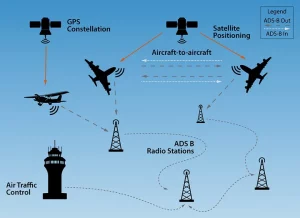ADS-B: What’s the Big Deal?
In an industry that is endlessly evolving like aviation, it is imperative that technology within aircraft remain up to date, too. Automatic Dependent Surveillance-Broadcast (ADS-B) is an innovative system that was developed to reshape the way aircraft are tracked and monitored, enhancing safety and efficiency across the aviation industry.
What is ADS-B?
ADS-B is a surveillance technology that allows aircraft to continuously broadcast their identification, position, altitude, and other important information to ground stations and other nearby aircraft. Unlike traditional radar systems, ADS-B does not rely on external interrogation; instead, it uses the aircraft’s avionics to transmit the critical data.
 The Main Function of ADS-B and How Does it Work?
The Main Function of ADS-B and How Does it Work?
The primary function of ADS-B is to provide a more comprehensive and accurate picture of aircraft locations and movements. By continuously transmitting their position and other data, aircraft equipped with ADS-B can be tracked with greater precision and reliability than traditional radar systems. This increased situational awareness is crucial for air traffic control, improving safety and reducing the risk of collisions or other incidents.
Each aircraft broadcasts vital information including its precise location, speed, and unique identity – sharing this data with both air traffic controllers and nearby aircraft. This stems from the aircraft’s navigation equipment, which taps into satellite signals to pinpoint its exact position and movement through the air. ADS-B systems work by gathering data from multiple instruments onboard, and creates a complete digital snapshot of the aircraft’s status, broadcast through specialized ADS-B channels. This continuous stream of updates is known as “ADS-B Out”, and it keeps everyone informed on the ground and in the air, about the smallest changes in the aircraft’s route. Any aircraft equipped with ADS-B receivers can pick up signals if they are within about 250 miles and have a clear path to the broadcasting aircraft. At the same time, ground stations are also listening for these signals, and are giant data collectors, gathering flight information and converting it into easy-to-read displays for air traffic controllers. This allows controllers to keep aircraft safely separated from each other.
![2024.Airspace [chart].Federal Aviation Administration.](https://media.pea.com/wp-content/uploads/2024/11/Alt-text2024.Airspace-chart.Federal-Aviation-Administration-1-300x287.png) Why is ADS-B Important?
Why is ADS-B Important?
The aviation industry reached a milestone with the implementation of the ADS-B Out mandate. As of January 1, 2020 aircraft flying in certain high-traffic airspaces are now required to be equipped with ADS-B Out technology. However, there are some exceptions. For aircraft that operate exclusively in airspaces where transponders are not mandated, there is no requirement to install ADS-B Out technology. There are also certain aircraft types without electrical systems, such as balloons and gliders, that are exempt from the ADS-B mandate, even in transponder-required airspaces. The intention of creating this mandate was to create a safer environment when flying in over-saturated airspaces. It has become an increasingly important technology in the aviation industry and there are several reasons why:
- Enhanced Safety: The real-time tracking and monitoring capabilities of ADS-B allow for better collision avoidance, improved weather awareness, and more efficient emergency response if needed.
- Improved Efficiency: By providing more accurate and up-to-date information about aircraft locations, ADS-B enables air traffic controllers and pilots to optimize flight paths, reduce fuel consumption, and streamline overall operations.
- Regulatory Compliance: Many countries have implemented or are in the process of implementing mandates requiring the use of ADS-B in certain airspaces, making it a necessary technology for operators to comply with evolving regulations.
Interested in learning more about Phoenix East Aviation and the flight training they provide? Email info2@pea.com to get in touch with their Admissions Department. Interested in learning more about ADS-B and the Federal Aviation Administrations rules and regulations? Check out their frequently asked questions.
*this blog has been written as an educational support document and it does not supersede what PEA’s flight training department teaches its pilots*
References:




